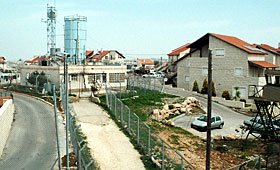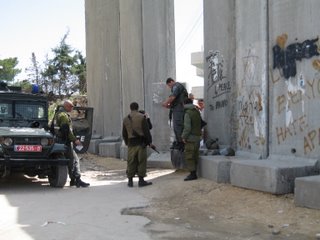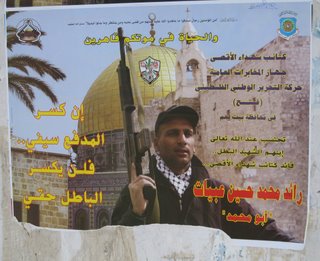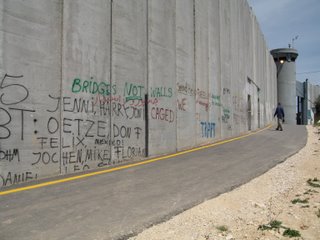Getting an Education
Sorry it has been a while since my last entry. It’s been a very thought-provoking week, and I’ll share some of it with you now. I’ll apologize for the length of this entry, but there’s a lot I feel I need to tell you all.
On Friday, I was invited to visit the home of a Seed from 2004 (Alon – his picture is on the last post). I met Alon at the Seeds Café last week and he invited me to come along with Eric and Jesse (two brothers who work for Seeds of Peace) when they came over to his house.
Alon lives in a settlement community called Givon Hahadasha. The name means “New Gibeon”, since it is located right next to the site of the biblical Gibeon (now a Palestinian town called Al-Jib), where according to the bible, the sun stood still for Joshua as he fought a battle during the conquest of the land of Canaan. It is a small community of about 1,300 residents that initially started in an abandoned Jordanian army base. It is a beautiful community, perched on top of a hill, with panoramic views overlooking the neighbouring hills, nice houses and yards with basketball nets and satellite dishes.
After having some cake and tea, Alon took us for a tour around the perimeter of the settlement. Then it hit me: this is no ordinary suburb of Jerusalem. The community is completely surrounded by a fence with barbed wire and razor wire. As someone who has visited the concentration camps of Auschwitz and Majdanek, the image of barbed wire is one that carries a lot of emotional baggage. Seeing the barbed wire set up to protect this community brought a rush of conflicting emotions. Is this the type of state the Zionists hoped to create from the ashes of the Holocaust?
As we continued on our tour around the edge of the settlement, we could see where the security fence was being built (construction has been halted pending an Israeli supreme court ruling). We walked past the playground that was protected by slabs of concrete, meant to block any bullets from the Palestinian villages a few hundred meters away. The most interesting sight we saw came next. Here the fence takes a sharp turn. Beyond the fence is a narrow dirt walkway, bordered on the other side by another fence. Following the walkway with my eyes, I could see that it led to a small house that didn’t fit in with the large modern homes of the settlement. It was a small, one-story home that belonged to a Palestinian family, and it was completely surrounded by a 10-foot fence, and beyond the fence, the settlement. I didn’t have my camera here, but I was able to find a picture of the home on the web.

According to Alon, the settlers had offered this Palestinian family a large sum for their home, but they refused to sell it. Understandably, there are social repercussions for Palestinians who sell their land to Israelis. So here we have the situation of this tiny Palestinian island inside the Jewish settlement, which is itself an island surrounded by other Palestinian towns. I’m starting to see the difficulty of separating these two peoples here.
Saturday brought a whole new educational experience.
A board member from Seeds of Peace was in town and Eric had set up a “Seam line” tour for the board member and his wife. I was lucky enough to be able to tag along.
I thought a lot about the terminology of the “Seam” that represents Israel’s pre-1967 border. It evokes the image of a country stitched together. You can almost picture the threads straining against the tensions of two nations pulling in opposite directions.
We started the tour driving through East Jerusalem, which was annexed by Israel in 1967. Anyone who says that Jerusalem was “unified” in 1967 has probably never been to East Jerusalem. The vast majority of Israelis and Jews never venture to this side of the city that is home to over 200,000 Palestinians. Since East Jerusalem was annexed by Israel (as opposed to the rest of the West Bank and Gaza, which are “occupied”), Palestinian residents of Jerusalem were given special status. After the annexation, the residents were given the option to apply for full Israeli citizenship (with all of the benefits of voting rights for the Knesset), however most Palestinians refused because this would have entailed a sworn oath of allegiance to Israel. Those Palestinians who do not have full Israeli citizenship could apply for a “Jerusalem Resident” card that is quite coveted in the Palestinian society, because it provides for additional freedom in traveling around Israel and through various checkpoints. Jerusalem residents who are not Israeli citizens can still vote in municipal elections (but not for the Knesset).
As we continued the tour along the controversial “Security Wall”, I was struck by the sheer size and scale of it. I should point out that for over 90% of its length, the wall is not really wall at all, but a chain-link fence. In these locations however, there are roughly a hundred meters on each side of the fence that act as no-man’s land, and provide a buffer between the two sides. Of course, in the densely populated areas around Jerusalem, there just isn’t the space to do that, so instead we have the 30-foot poured concrete walls. The wall is constructed with huge slabs of concrete that were individually poured. The slabs have holes in the top so that they can be moved around with a crane. The Israeli government has always maintained that these walls are a “temporary security measure” however, it’s hard to argue with the view that the government is trying to unilaterally define the future borders of Israel.

Here’s a view of a section of the Wall with the Old City and the Dome of the Rock in the background.

Here is a picture of a point in the wall where one of the slabs was knocked over. Rather than put the wall back in place, the IDF set up an improvised checkpoint by stationing a Jeep here with 4 soldiers. You can see the soldiers checking ID cards and allowing people to pass back and forth. It’s amazing to think that for the years between 1967 and the construction of the Wall, there was virtually unimpeded access between the West Bank Towns and the rest of Jerusalem, and so a huge number of Palestinians used to live on the West Bank and work in Jerusalem with little inconvenience. Now, this access has been cut off, and forced through regulated checkpoints. I can see how this would make it much harder for would-be suicide bombers to make it into the heart of a Jewish neighbourhood, but I can also imagine the frustration for the Palestinians who used to make a living on the other side.
We continued our tour by heading over to Bethlehem, the birthplace of Jesus. Bethlehem is home to the Church of the nativity, built in 330 A.D. over the grotto where Jesus is believed to have been born. In order to get to Bethlehem, we had to pass through a checkpoint, unfortunately, our driver, Mezzin (a Palestinian with a Jerusalem resident ID), was not allowed to enter through this checkpoint because of the IDF-imposed closure. Paradoxically, when we were turned away, we were able to simply take an alternate route, and get into the city without passing through a checkpoint.
Once we made it into Bethlehem, we were greeted by the site of a fairly prosperous-looking town. Bethlehem is mainly Muslim, but has a strong minority of Palestinian Christians.
As we were walking through the town I came across this poster that was still up from the Palestinian elections.

I took a picture of the poster, simply assuming that based on the imagery of the machine-gun toting militant and the Dome of the Rock, this must be an advertisement for Hamas. When I got home, I looked up the emblem in the center of the poster, and discovered that this was actually a poster supporting the Fatah party of Mahmoud Abbas. I have to admit, I am very confused. Is this the poster of a moderate party that recognizes Israel? Is this the party that the West was hoping would win the election instead of Hamas?

If you look closer at the Fatah emblem, you see that it is made up of two machine guns and a grenade, with the map of what the party considers Palestine – all of present-day Israel and the Occupied Territories. This is quite disconcerting. Is the emblem merely a remnant from the party’s more violent past? I hope so, but who knows?
As we were leaving Bethlehem, we walked through the new “terminal” checkpoint between Bethlehem and Jerusalem. Here is Eric walking through the pedestrian entrance. Normally, this area would be packed with Palestinians trying to go across (which can take hours), but since Israel has declared a “Closure” the checkpoint was empty.

A wall of this size is a graffiti writer’s dream. I was particularly struck by some of the language of despair spray-painted on the wall. Words like “ghetto”, “trapped” and “cage” were all over. What must this be doing to the Palestinian psyche?
 This is Eric at the entrance into the checkpoint. I don’t have pictures from inside (I didn’t want to provoke the ire of any soldiers), but we went through at least two of these metal turnstile doors, while we were monitored by Israeli army girls behind bomb-proof glass. This made security at Ben-Gurion Airport look like Disneyland.
This is Eric at the entrance into the checkpoint. I don’t have pictures from inside (I didn’t want to provoke the ire of any soldiers), but we went through at least two of these metal turnstile doors, while we were monitored by Israeli army girls behind bomb-proof glass. This made security at Ben-Gurion Airport look like Disneyland.This stuff is all pretty controversial, so if I’ve said something that you disagree with, please let me know. I am trying not to take sides here, which is tough, because I was brought up like most North American Jews, with a deep reverence for the state of Israel and its place in history, and a healthy dose of Zionism. One of the things that I’m understanding here is that virtually everyone has taken a side. Every story has at least two (if not three or four) interpretations, so I’ll try to stick to facts and my own thoughts and impressions, which you should take for what they are.
Take care, and I’ll post again soon.
- Seth

4 Comments:
Excellent report, Seth.
Seth,
The scenes that you describe are fascinating and disheartening. Still, I am very torn about the fence. Sometimes, I am more optimistic and think it really is temporary. There is certainly a precedent for moving these kinds of fences: I'm pretty sure that Israel moved its fence at the Lebanese border (or maybe it was in Lebanon) even a very short distance to comply with UN regulations. I guess the idea is the if Israel can dismantle settlements in the West Bank and move behind the fence, then they can really negotiate from a position of strength. There is an important difference between peace and security. If all the Israelis want is security, and they create that security unilaterally, then maybe the only thing the Palestinians will be able to offer is genuine peace. This is a very long-term scenario, and I'm not sure I even agree with the method, but perhaps it's an optimistic way of looking at the fence and unilateral action more generally.
Finally, I just want to point out the while the situation you describe in Jerusalem is grim, Jerusalem is not all of Israel. For a very different picture of Arab-Jewish relations, you must travel to Haifa. It's not perfect, but it's a lot better.
Seth, your entry was really interesting, informative and eye-opening. It's great that you are getting to see the day-to-day details of the conflict first-hand, because I think that is where the real problem (and solution?) lies, and, sadly, exposure to micro-level interactions and realities is what the rest of the world misses most of the time.
I also wanted to assure you that I think of all people you have a great ability to be un-bias, mostly because you are so thought-out and self-aware. If there was anyone I could trust to paint a picture of the reality in Israel it would be you: your reflections point out issues, rather than giving strong opinions or condemnations. Moreover, you have explained what you've seen by telling us the way it made you feel, which can't be controversial!
All, Thank you very much for the comments - sorry they were not showing up before. I had to "republish" the blog to get them up.
I'm really enjoying reading your comments!
Cheers,
Seth
Post a Comment
<< Home